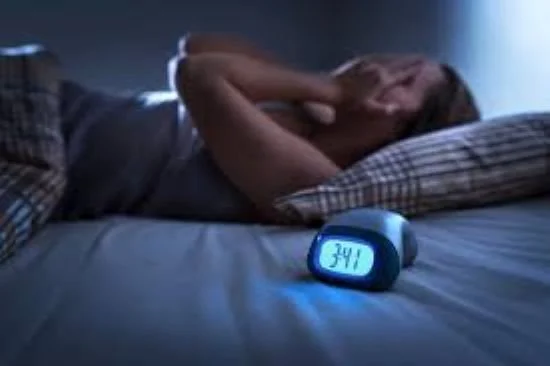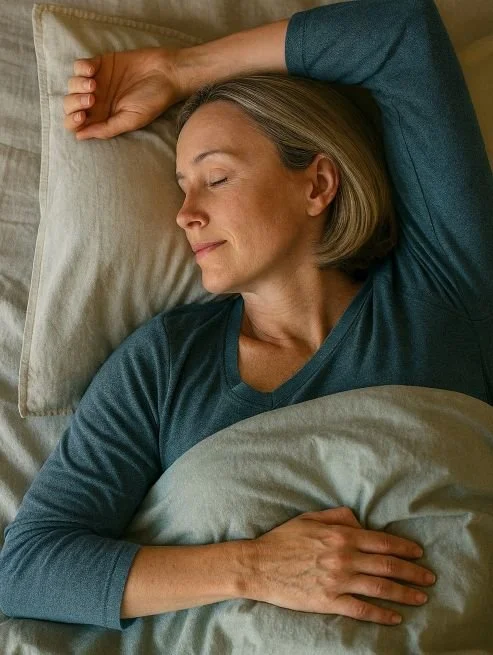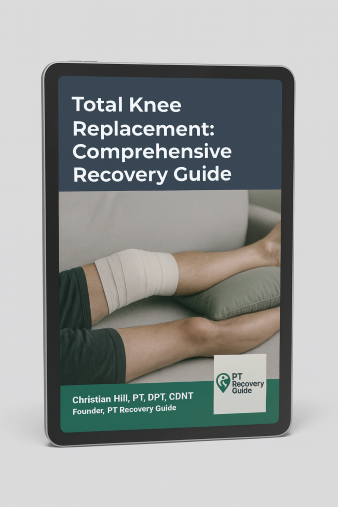Sleep After Surgery: Why It Matters and How to Improve It
✅ Introduction:
Ask any patient after a total knee replacement (TKA) what the hardest part of recovery is, and many will give a surprising answer: sleep.
Instead of drifting into restorative rest, they describe nights of constant repositioning, waking with sharp knee pain, or feeling like their brain just won’t “switch off.” For some, the lack of quality sleep becomes as disruptive as the pain itself.
This isn’t unique to knee surgery. Sleep disruption is common after almost all major operations. But with TKA — one of the most frequently performed orthopedic surgeries worldwide — the problem is especially well-documented.
And poor sleep is more than a nuisance. It feeds back into pain sensitivity, slows down tissue healing, clouds mood, and makes it harder to engage in rehabilitation. In short: if your nights are broken, your days of recovery will be harder.
This article breaks down:
Why sleep is so disrupted after surgery (with TKA as the focus).
Why sleep matters for healing and recovery.
What the research actually shows.
Practical, research-supported strategies to make nights easier.
Why Sleep Gets Disrupted After Surgery
Patients often expect pain or limited mobility after surgery — but many are blindsided by the sleep disturbance that follows. Several overlapping factors create this “perfect storm.”
Pain Amplification at Night
During the day, sensory input is spread across many channels: light, sound, conversation, activity. At night, the environment goes quiet. Pain signals, still firing from the surgical site, become the dominant input.
This makes discomfort feel louder and sharper, even if pain intensity hasn’t changed physiologically. Patients describe it as:
“My knee starts throbbing the minute I try to fall asleep.”
“It feels like every heartbeat is echoing in my knee.”
Studies consistently show that pain is the leading reason patients report poor sleep after TKA, particularly in the first 4–6 weeks.
Medications and Sleep Architecture
Opioids — the most common early pain medication — are double-edged. While they reduce pain, they:
Fragment sleep into shorter bouts.
Suppress deep (slow-wave) and REM sleep.
Increase risk of nighttime awakenings.
Other drugs prescribed postoperatively can also interfere:
Steroids (sometimes used in surgical protocols) elevate energy levels and blunt circadian rhythms.
Anti-nausea drugs may cause restlessness.
Sedatives help with falling asleep but don’t always improve restorative sleep quality.
The result: patients may “sleep” for 7 hours, but wake unrefreshed — because the deeper, restorative stages were suppressed.
Environment and Positioning Challenges
Hospital phase: Sleep is broken by noise, bright lights, vital checks, and early-morning wake-ups.
At home: Many patients cannot lie comfortably in their normal sleeping position. Side sleepers often struggle most, since incisions, swelling, and positioning devices make side-lying painful.
It’s common for patients to spend the first several weeks in a recliner or propped-up bed arrangement. While functional, this is rarely as restorative as their normal bed.
💡 Curious what else to expect in the first month after surgery? Read our guide on recovery during the first 4 weeks after knee replacement.
Stress and Anxiety
Even if pain is controlled, the mind may not settle:
“What if I roll over wrong and hurt the new knee?”
“Will this pain ever go away?”
“Am I behind on my recovery compared to others?”
This mental arousal triggers the sympathetic nervous system (the “fight or flight” branch), raising heart rate and preventing the relaxation needed for sleep onset.
Physiological and Circadian Disruption
Surgery itself is a stressor to the body. The cascade of inflammatory cytokines (IL-6, TNF-α, CRP) and the disruption of daily activity patterns can interfere with circadian rhythm — the body’s internal clock.
A pilot wearable-monitor study after TKA found significant reductions in deep and restorative sleep in the first postoperative week compared to baseline. Patients weren’t just imagining poor rest — their actual sleep architecture was measurably altered.
Mechanical Limitations
Braces, pillows, or positioning instructions (“keep the leg straight,” “don’t cross legs”) can force patients into positions they rarely use. Over time, this mismatch with habitual sleep postures itself becomes a barrier to sleep.
Myth vs. Fact
Myth: “I’ll be so exhausted from therapy that I’ll sleep like a baby.”
Fact: Pain, swelling, and circadian disruption can override fatigue. Sleep after surgery often requires intentional planning, not just waiting for exhaustion.
Why Sleep Matters for Recovery
Why give so much attention to sleep? Because sleep is not passive downtime. It’s an active physiological state that influences nearly every aspect of recovery.
Pain Sensitivity
Sleep and pain form a vicious cycle:
Poor sleep increases pain sensitivity.
Higher pain makes it harder to sleep.
Even one night of lost sleep can make pain feel more intense and harder to tolerate. Studies show that sleep-deprived individuals have lower pain thresholds and reduced ability to modulate painful stimuli.
Healing and Inflammation
Deep sleep (slow-wave sleep) triggers release of growth hormone, which aids tissue repair.
Adequate sleep improves immune system function, helping control infection risk.
Chronic sleep deprivation raises systemic inflammation — the opposite of what you want after joint surgery.
💡 Want to learn more about how inflammation impacts recovery? Check out our article on controlling inflammation after surgery.
Mood and Cognition
Fatigue, irritability, and difficulty concentrating are common when sleep is fragmented. This can:
Increase risk of depression and anxiety during recovery.
Reduce motivation to complete home exercise programs.
Make it harder to follow instructions or track progress.
Functional Recovery
While fewer studies have directly linked sleep quality to functional outcomes after TKA, it’s easy to connect the dots:
Better sleep → more energy for therapy sessions.
Better sleep → lower pain sensitivity, enabling fuller motion during exercises.
Better sleep → improved adherence to rehab routines.
Key Takeaway
Sleep isn’t optional recovery time. It’s an essential therapy alongside exercise, nutrition, and medication.
What the Research Shows
Prevalence and Course
In the first 1–6 weeks, nearly all patients report disrupted sleep. One study found 99% incidence of poor sleep in the first postoperative week.
At 3 months, many improve, but not all. Studies show that up to 40–50% still report poor sleep at this stage.
At 6 months, most patients return closer to baseline — but a subset continue to struggle.
Even years later, some long-term TKA patients still report poor sleep, suggesting that habits and psychological factors can perpetuate insomnia even after pain subsides.
Predictors of Poor Sleep
Preoperative sleep disturbance.
Higher baseline pain and anxiety.
Depression or low mood.
Greater severity of osteoarthritis.
Interestingly, hip replacement patients often report faster sleep recovery than knee patients — possibly because knee pain is more movement-sensitive and persistent.
Objective Evidence
Wearable sleep monitors confirm:
Reduced deep (N3) sleep in the first week.
Less REM sleep, particularly in opioid users.
Fragmented architecture (frequent awakenings).
This validates patient reports: it’s not “just perception” — sleep physiology is genuinely altered.
Practical Strategies to Improve Sleep
Patients often ask: “What can I actually do?”
The best approach is a mix of comfort-focused adjustments and healthy sleep habits.
1. Positioning and Comfort
Elevate the limp: Reduces swelling and throbbing at night. Use pillows or a wedge under the calf (not directly behind the knee), for TKA.
Pillows for support: Place between knees or under the ankle to offload pressure.
Compression sleeve: A light knee sleeve may reduce incision sensitivity and “rawness.”
Recliner or wedge pillow: Helpful in the first 2–4 weeks until bed mobility improves.
2. Pain Management (as prescribed)
Time medication so peak relief coincides with bedtime.
Ice and elevate in the evening before sleep.
Avoid stacking sedatives: Combining opioids, sleep aids, and alcohol is unsafe.
Taper opioids gradually: Reduces long-term sleep fragmentation.
3. Sleep Hygiene Basics
Keep consistent sleep and wake times.
Create a cool, dark, quiet environment.
Limit caffeine after lunch.
Avoid screens for at least 30–60 minutes before bed.
Ask your physician about melatonin or natural aids — safe for some, not all.
4. Daytime Movement and Exercise
Light daytime activity improves sleep drive.
Avoid intense rehab or exercise right before bed (can flare pain).
Aim for balanced activity: too much rest can also worsen nighttime restlessness.
5. Relaxation and Stress Management
Try breathing exercises: Inhale 4 sec → hold 2 sec → exhale 6 sec.
Use guided relaxation apps or calming playlists.
Simple mindfulness routines before bed can ease “racing thoughts.”
If insomnia persists beyond 2–3 months, your physician may recommend evaluation for CBT-I (cognitive behavioral therapy for insomnia).
Caution
Avoid combining multiple sleep aids. Even “natural” supplements like valerian or CBD can interact with prescribed medications. Always clear new remedies with your physician.
When to Seek Help
Insomnia lasting more than 3 months.
Loud snoring, pauses in breathing, or waking up gasping.
Severe mood changes linked with poor sleep.
Daytime sleepiness that interferes with safety (e.g., falling asleep during conversations).
Ongoing reliance on multiple sleep medications.
These are signals to involve your surgical team, primary care provider, or a sleep specialist.
Conclusion
Sleep disruption after a large orthopedic procedure is common, predictable, and can be improved.
Understanding why it happens takes away some of the fear. Applying simple, evidence-based strategies, from positioning to sleep hygiene, helps patients regain control of their nights.
Recovery is not just about what happens in the clinic or during the day. Recovery continues at night. and quality sleep is one of the most powerful medicines you can give your body.
📚 References
Pettit RJ, et al. Total Joint Arthroplasty and Sleep: The State of the Evidence. J Clin Sleep Med. 2024. PMID: 38931991.
DePhillipo NN, et al. High incidence of acute self-reported sleep disturbances in patients following TKA. J ISAKOS. 2021;6(6):361-366.
Alipourian A, et al. Improvement of sleep quality 6 months after total knee arthroplasty. J Orthop Surg Res. 2021;16:426.
Staffe AT, et al. Total sleep deprivation increases pain sensitivity: Effects on pain processing in healthy subjects. PLoS One. 2019;14(12):e0225849.
Stroemel-Scheder C, et al. The Effects of Recovery Sleep on Experimental Pain. J Pain. 2023;24(12):1931-1942.
Total Knee Replacement - Comprehensive Guide
Take Control of Your Recovery
Not every factor after a knee replacement is in your hands: age, medical history, or surgical complexity all play a role. But the research is clear: the choices you make during recovery can strongly influence your results.
That’s why I created the Comprehensive Total Knee Replacement Recovery Guide. It’s a 68-page, step-by-step plan that shows you how to:
Extensive education regarding the post-surgical process including timeline and lifestyle topics including driving, stairs, and travel.
Build strength and mobility safely with the right exercises.
Stay on track with milestones that match the phases of healing.
Avoid common pitfalls that slow recovery.
Focus on the controllable factors, like consistency, movement, and lifestyle habits that research shows make the biggest difference.
If you’ve been looking for guidance you can trust, backed by both clinical experience and published evidence, this guide is for you.
Want trusted recovery tips delivered to your inbox?
Our readers tell us the hardest part of knee replacement isn’t just the surgery — it’s knowing what to expect next. Join our email list, and you’ll get clear, research-backed guidance and resources as soon as they’re published.
Stay Updated on TKA Recovery
Want reliable, easy-to-understand information about life after knee replacement?
Enter your email below to get new articles, resources, and updates as they come out.
Additional Resources:
🦵 Prehab Before Knee Replacement: How to Prepare Your Body and Mind for Surgery
What No One Tells You About Knee Replacement Recovery (Post-Surgical Part 1)
TKA Recovery Months 2–3: What to Expect and How to Keep Making Progress
What to Expect After Knee Replacement: Outcomes, Satisfaction, and Key Factors That Shape Recovery
Rehab Exercise Progression: A Patient’s Guide to Safely Advancing Your Recovery
Understanding Inflammation: How to Heal Smarter, Not Just Harder
Managing IT Band Syndrome: A PT’s Guide to Relieving Pain and Getting Back to Activity
Protein & Recovery — Does It Really Matter Before and After Surgery?
Ice vs Heat for Injury: A Physical Therapist’s Guide to Pain & Swelling Relief
Recommended Rehabilitation Supplies:
Research Summaries:
Written by Christian Hill, PT, DPT, CDNT – Licensed Physical Therapist with over 10 years in orthopedic rehab.
This article is for educational purposes only and is not a substitute for professional medical advice. Always consult with your healthcare provider before beginning any new rehabilitation or treatment plan.



